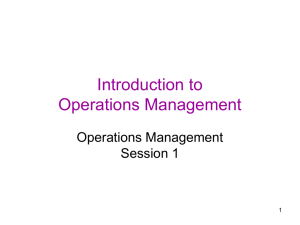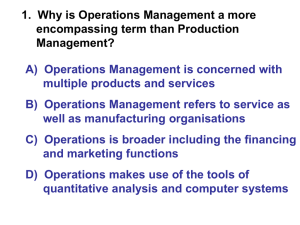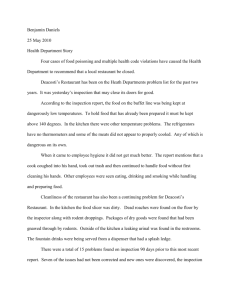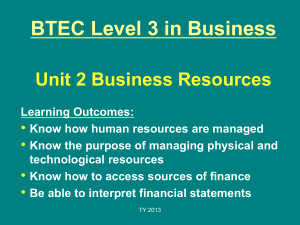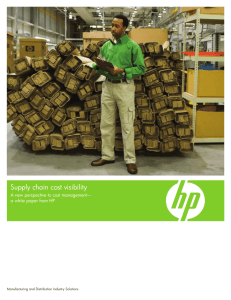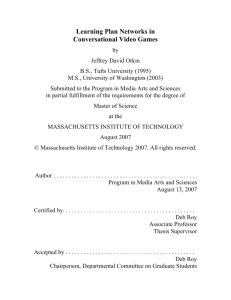Operations Management Exam Questions and Answers
advertisement
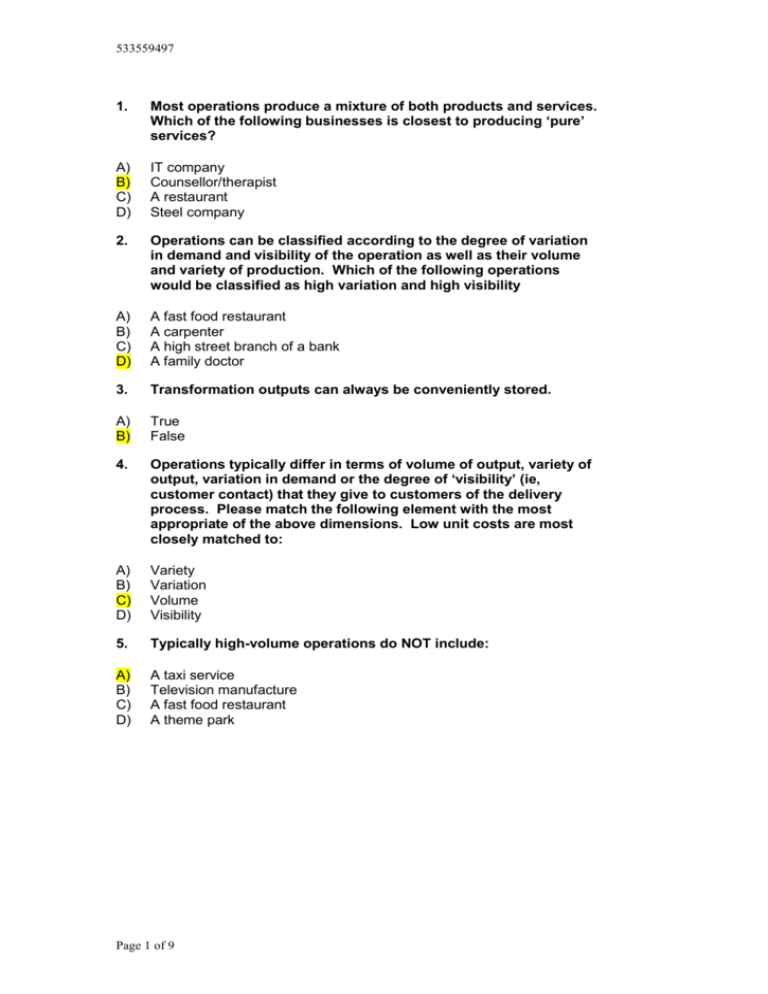
533559497 1. Most operations produce a mixture of both products and services. Which of the following businesses is closest to producing ‘pure’ services? A) B) C) D) IT company Counsellor/therapist A restaurant Steel company 2. Operations can be classified according to the degree of variation in demand and visibility of the operation as well as their volume and variety of production. Which of the following operations would be classified as high variation and high visibility A) B) C) D) A fast food restaurant A carpenter A high street branch of a bank A family doctor 3. Transformation outputs can always be conveniently stored. A) B) True False 4. Operations typically differ in terms of volume of output, variety of output, variation in demand or the degree of ‘visibility’ (ie, customer contact) that they give to customers of the delivery process. Please match the following element with the most appropriate of the above dimensions. Low unit costs are most closely matched to: A) B) C) D) Variety Variation Volume Visibility 5. Typically high-volume operations do NOT include: A) B) C) D) A taxi service Television manufacture A fast food restaurant A theme park Page 1 of 9 533559497 6. Operations can be classified according to their volume and variety of production, as well as the degree of variation and visibility. Which of the following operations would be classified as high volume, low variety? A) B) C) D) A fast food restaurant A family doctor A high street branch of a bank A carpenter 7. Which of the following is NOT a response from operations to the changing business environment? A) B) C) D) Flexible working patterns Lean process design Technology replacing manual jobs Mass marketing 8. Service processes that have a high number of transactions, often involving limited customisation, are called: A) B) C) D) Dual services Mass services Low-complexity services Service runners 9. The amount of value-added activity that takes place in the presence of the customer is called: A) B) C) D) Visibility Variety Value-added Variation 10. Which of the following is an implication of low variety? A) B) C) D) Low unit cost Flexibility needed High complexity Matching customers specific needs 11. Which of the following is NOT an implication of high visibility? A) B) C) D) Time lag between production and consumption High unit cost Satisfaction governed by customer perception Customer contact skills needed Page 2 of 9 533559497 12. Which of the following is NOT a process input? A) B) C) D) Transported passengers for a train service Information for the police Aircraft for an airline Sales staff for a department store 13. Using the transformation model, a transformed resource might be A) B) C) D) A manufacturing shop A waitress A customer A bank clerk 14. Creating customer value does NOT include A) B) C) D) increasing the perceived benefits decreasing the time costs increasing the perceived sacrifice decreasing the psychological costs 15. Which of the following is NOT a characteristic of a production-line approach to provide a service? A) B) C) D) Division of labor Substitution of technology for people Standardisation of the process and the service provided High employee autonomy 16. The term “customer contact” refers to A) B) C) D) The handling of the product by the customer The influence the customer has on service design The amount of time spent waiting in the system The physical presence of the customer in the system 17. For companies offering customised services, which one of the following is true? A) B) C) D) A comprehensive employee recruitment process is very important Employee tasks are low skilled A production-line approach to service is desirable Information processing plays a minor role 18. When an organisation is focused on high variety there is A) B) C) D) Minimal customer experience Routine, automated processing Low customer contact skills Significant customer experience Page 3 of 9 533559497 19 Transforming resources include: A) B) C) D) Materials Information Staff Customers 20 Operations Management is defined as the activity of managing the resources which are devoted to: A) B) C) D) the management of products and services the production and delivery of products and services the resources which produce products and services the products and services which are managed 21. R.G Schroeder’s 5 decision areas in Operations Management are: A) B) C) D) planning, technology, production, inventory, control process, capacity, inventory, workforce, quality process, technology, capacity, workforce, quality none of these 22. Why is Operations Management a more encompassing term than Production Management? A) Operations Management is concerned with multiple products and services Operations Management refers to service as well as manufacturing organisations Operations is broader including the financing and marketing functions Operations makes use of the tools of quantitative analysis and computer systems B) C) D) 23. A transformed input into a large public hospital from the service point of view would be A) B) C) D) physicians’ services patients nursing services administration services 24. In most organisations the greatest part of total investment is in A) B) C) D) finance stock and work in progress the operations area design Page 4 of 9 533559497 25. A key difference between products and services is that products can be A) B) C) D) machined stored designed quality controlled 26. In service operations, the visible operations are, A) B) C) D) the accounts department the location of senior staff the location of customer contact the location of the non-contact support services 27. In services, operations that would be non-visible are, A) B) C) D) the washroom staff offices the location of customer contact the location of the non-contact support services 28. Frederick Taylor advocated a theory of A) B) C) D) motivation scientific management work study ergonomics 29 In most organisations the largest number of people report to A) B) C) D) the operations manager the personnel manager the marketing manager the gatekeeper 30 The key focus of Operations is A) B) C) D) meeting the needs of external customers meeting the needs of internal customers maximising revenue maximising efficiency 31 A useful model to characterise the two contrasting aspects of service operations is A) B) C) D) Front Office v Operations Centre Front Office v Peripheral Activities Front Office v Back Office Design Office v Operations Centre Page 5 of 9 533559497 32. Services transform A) B) C) D) the customer the organisation the producer the world 33 Operations management is A) B) C) basic engineering principles applied to an organisation common sense the use of computer based systems in production and service management a creative and progressive approach to managing the transformation of resources D) 34 Implicit Services include: A) B) C) D) Training of service personnel Comprehensiveness Attitude of service personnel Availability 35 Examples of front office activities include: A) B) C) D) cheque-clearing processes for a retail bank computer repair processes a management consultant working with a client most manufacturing processes. 36 A productive systems approach A) B) C) D) View operations as a separate organisation function Must provide feedback information for control of process inputs and technology Is of limited use in service organizations Disregards human and social concerns 37 People processing services require? A) B) C) D) A high degree of vertical integration High fixed costs A physical presence High equipment utilization 38 The type of operation that best describes the position of a waiter at a restaurant would be classed as: A) B) C) D) Front Office Back office Hybrid office Inner Office Page 6 of 9 533559497 39 A sales representative could be classified as: A) B) C) D) Back Office Hybrid office Front office Mid office 40 A service operation that is primarily back office is: A) B) C) D) A taxi driver Till operator at a bank A payroll assistant that calculates your wages The waitress at a restaurant 41 Which of the following statements concerning manufacturing and service organizations is generally true? A) A service facility is more likely to serve national or even international markets Manufacturing organizations generally find it more difficult to match capacity with demand In many service organizations customers themselves are inputs to the transformation processes. Most service organizations can buffer themselves against uncertain demand by creating inventories and smoothing output levels. B) C) D) 42 Which of the following concerning the term customer in operations management is true A) Manufacturing systems can have only internal customers because other departments are responsible for serving the external customer All customers are internal in manufacturing and external in services Only service organizations have external customers because service is provided in the presence of a customer. Customers can be internal or external in both manufacturing and service operations B) C) D) 43 Decisions that are unstructured and have long-term consequences are: A) B) C) D) Tactical decisions Operational decisions Strategic decisions Functional decisions 44 Which of the following is one accepted view of operations management: A) B) Relates to the financing of corporate assets A system where inputs pass through one or more operations and are transformed into outputs (goods or services) Relates to the development of personnel policies Relates to budgeting the annual resources between different functional areas. C) D) Page 7 of 9 533559497 45 Which of the following is NOT a trend in operations management? A) B) C) D) Increased role of services Increased presence of the manufacturing sector Increased global competition in both manufacturing and services Increased emphasis on quality 46 Operations management is applicable A) B) C) D) Mostly to the service sector To services exclusively Mostly to the manufacturing sector To all firms, whether manufacturing or service 47 Which of the following would not be an operations function in a fast-food restaurant? A) B) C) D) Advertising and promotion Designing the layout of the facility Making hamburgers and fries Purchasing ingredients 48 An operations manager is not likely to be involved in A) B) C) D The design of products and services to satisfy customers’ wants and needs The identification of customers’ wants and needs Work scheduling to meet the due dates promised to customers Forecasting sales 49 The “Father of Scientific Management “ is A) B) C) D) Henry Ford Frederick W Taylor W. Edwards Deming None of the above 50 Henry ford is noted for his contributions to A) B) C) D) Standardization of parts Statistical quality control Assembly line operations Time and motion studies 51 Which of the following is not a typical attribute of manufactured goods A) B) C) D) Output can be inventoried Often easy to automate Aspects of quality difficult to measure Production and consumption are separate Page 8 of 9 533559497 52 Which of the following is not a typical service attribute? A) B) C) D) Intangible product Easy to store Customer interaction is high Simultaneous production and consumption 53 All of the following are characteristics of today’s consumer market except A) B) C) D) Shorter product life cycles More customized products Longer product life cycles Product proliferation 54 Operations management is concerned only with the day-to-day operations of the firm’s productive system A) B) True False 55 Courses in operations management are relevant only to those who desire to be operations managers A) B) True False 56 Maintaining the quality of products and services is easier when production or delivery is closer to home A) B) True False 57 A process is a group of related tasks with specific inputs and outputs A) B) True False Page 9 of 9

